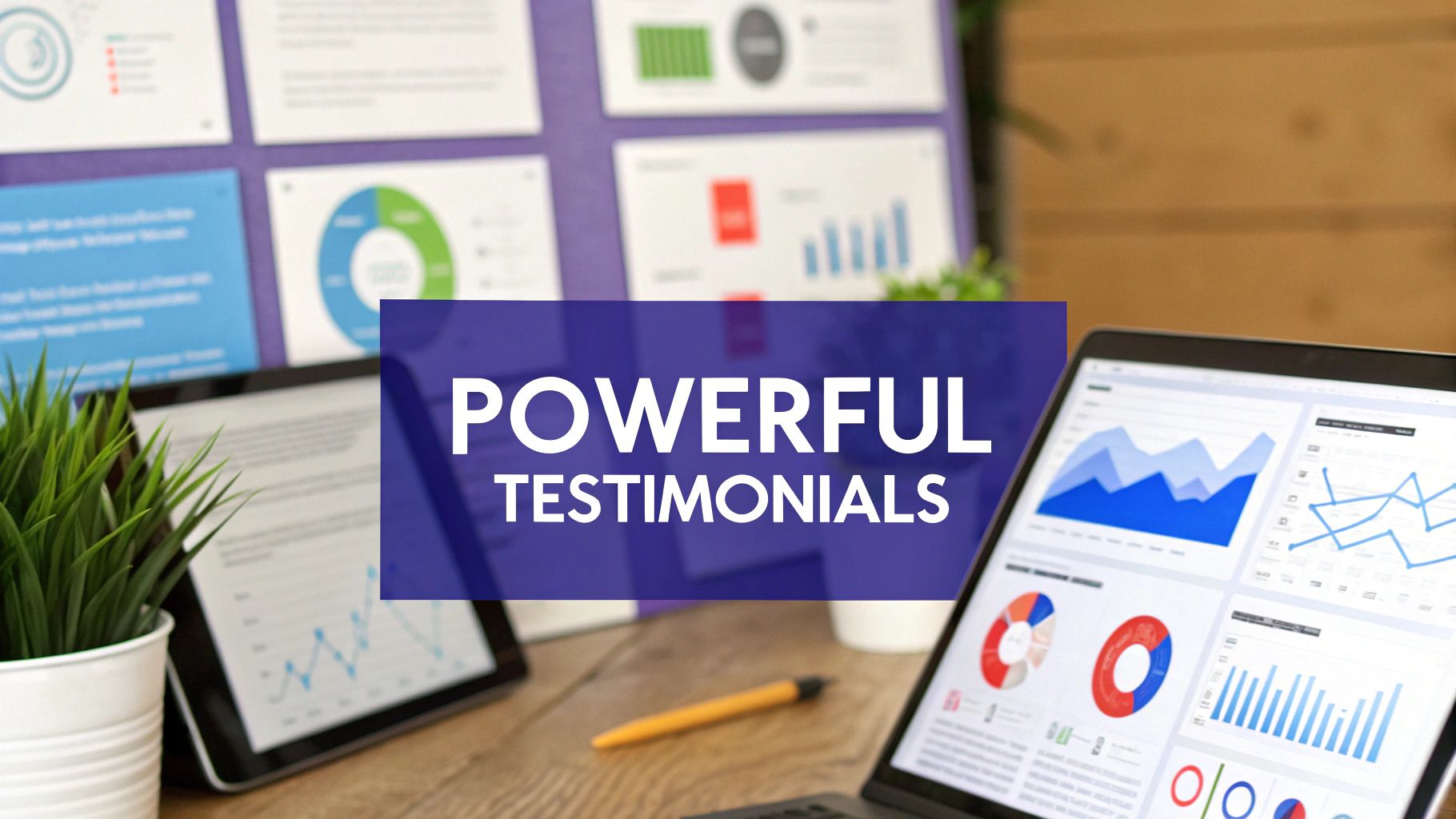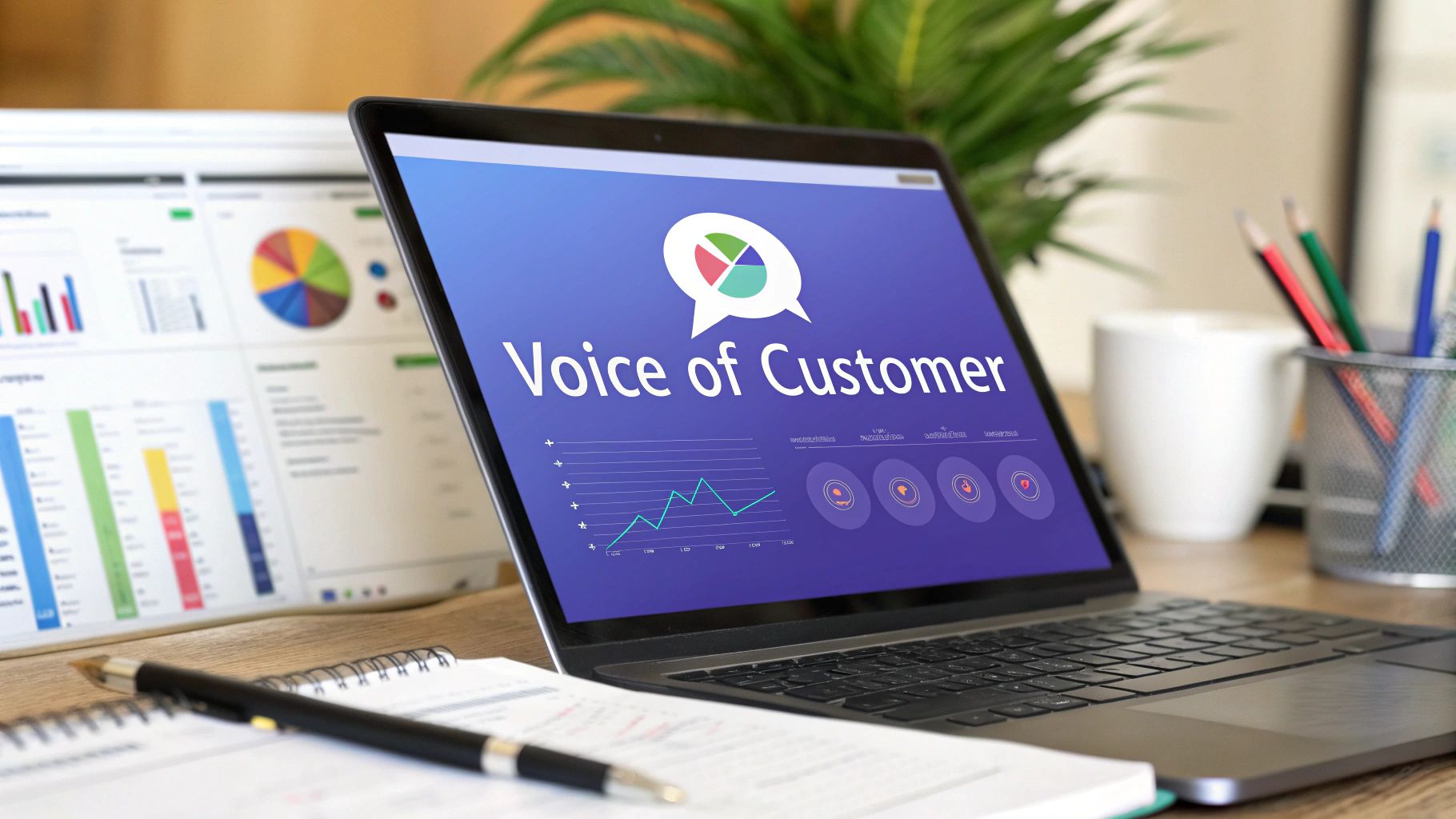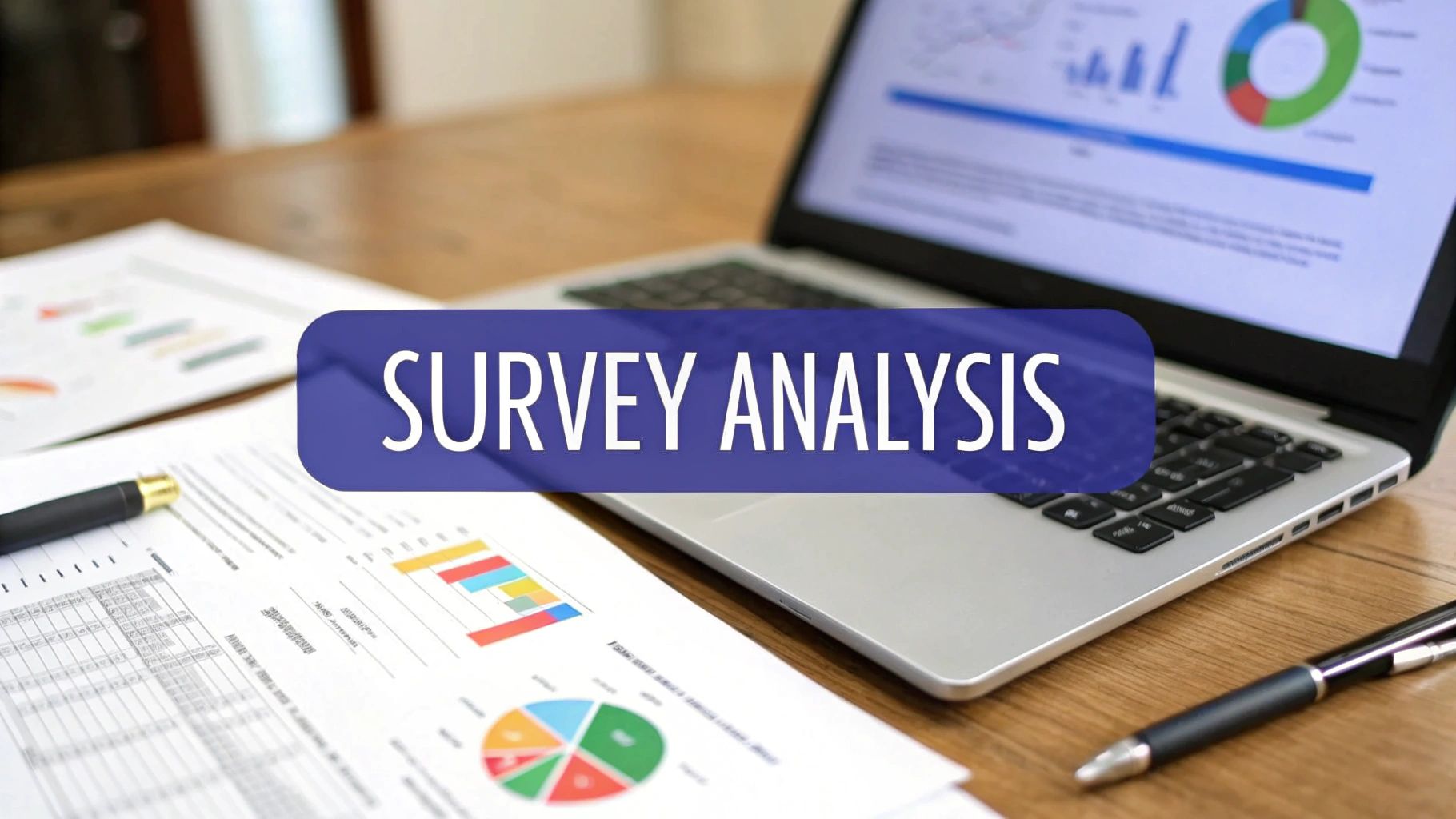8 Template for testimonials You Should Know
Discover the top 8 template for testimonials strategies and tips. Complete guide with actionable insights.
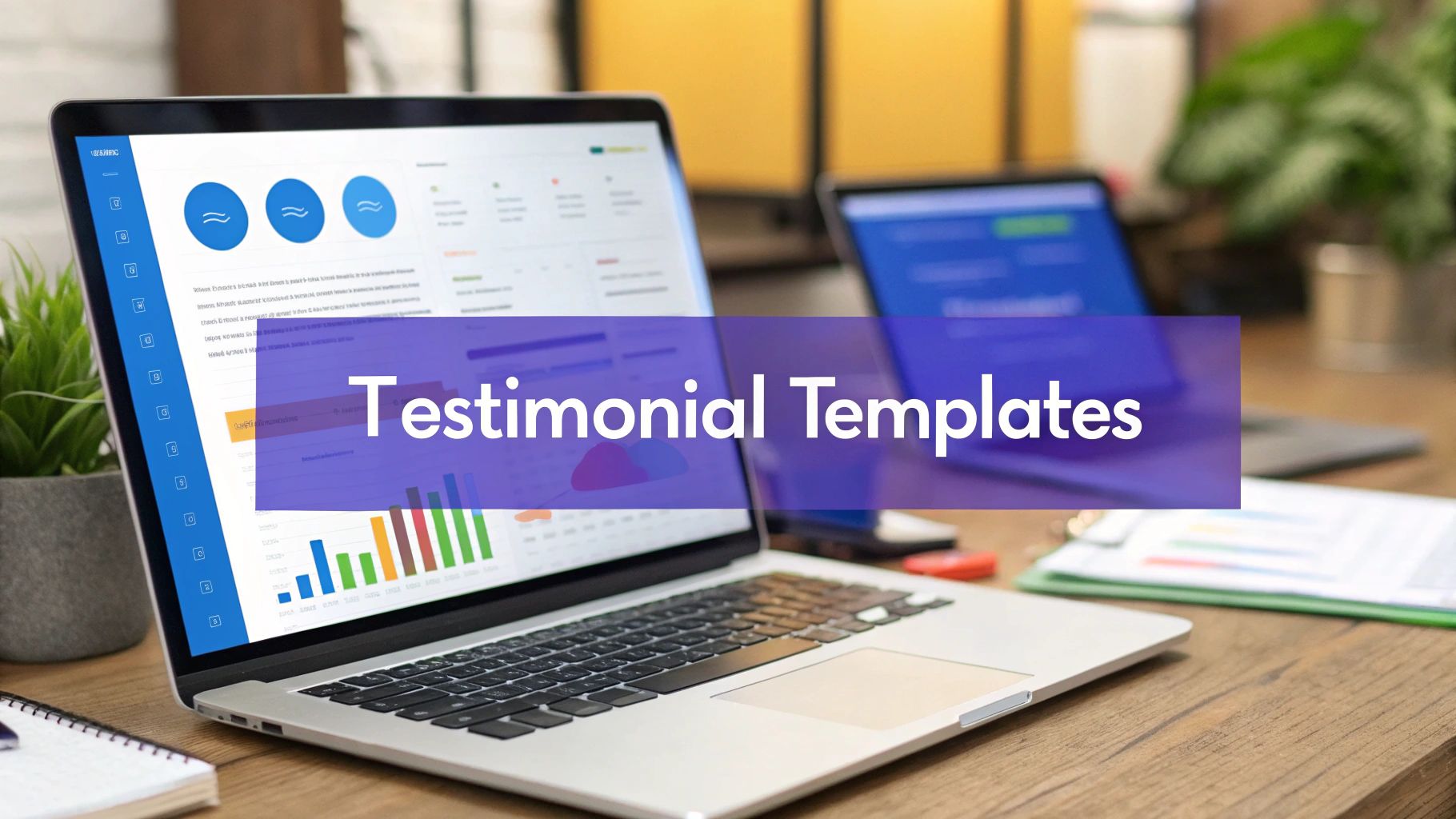
Authentic customer testimonials are one of the most powerful assets for any SaaS company. They build trust, validate your product's value, and directly influence purchasing decisions. However, getting customers to provide compelling, detailed feedback can be a challenge. Simply asking "Can you give us a testimonial?" often results in generic, unusable quotes. The key to unlocking impactful social proof lies in asking the right questions and structuring the narrative effectively. A well-designed template for testimonials provides the framework you need to guide your customers toward sharing specific, persuasive stories that resonate with your target audience.
This roundup provides eight distinct, customizable templates designed to help you capture high-quality testimonials for any scenario. From story-driven narratives to objection-handling formats, each template is crafted to extract the specific insights that move prospects to action. To ensure your testimonials are as impactful as possible, understanding principles of compelling marketing copy is essential. Mastering the art of small business copywriting will help you refine the final presentation of these customer stories, maximizing their conversion potential. We'll break down when to use each template, what questions to ask, and how to format the final result for maximum impact on your website, landing pages, and marketing materials.
1. The Story-Driven Testimonial Template
The Story-Driven Testimonial is more than a simple quote; it’s a complete narrative that guides potential customers through a relatable journey. This format leverages the classic story arc: a clear beginning (the challenge), a compelling middle (the solution), and a triumphant end (the transformation). By framing a customer’s experience as a story, you create an emotionally resonant and memorable account that builds deep trust and connection.

This template for testimonials is exceptionally powerful because it mirrors the prospect's own situation. They see their problems reflected in the "before" state and envision their desired success in the "after" state. Companies like HubSpot and Shopify have mastered this approach, creating in-depth success stories that showcase significant business growth and transformation, making the value of their platforms undeniable.
How to Implement This Template
To effectively capture a customer's story, you need a structured approach. Guide them through the narrative using targeted questions that uncover the essential plot points of their experience with your SaaS product.
- The Challenge (Before): Start by asking about the specific pain points they faced. What was the biggest obstacle? What solutions had they tried that failed? This establishes the conflict.
- The Solution (During): Focus on the discovery and implementation process. How did they find your product? What was the "aha!" moment when they realized it was the right fit?
- The Transformation (After): This is the climax. Ask for concrete results. How did the business change? Quantify the success with specific metrics like a 40% increase in lead conversion or a reduction in onboarding time from two weeks to one day.
When to Use This Approach
The story-driven format is ideal for high-consideration purchases where prospects need to understand the full impact of your solution. Use it for detailed case studies on your website, long-form blog posts, or video testimonials. It's particularly effective for demonstrating complex value propositions that a short quote can't capture, making it a cornerstone of any effective content marketing strategy.
2. The Problem-Solution-Result (PSR) Template
The Problem-Solution-Result (PSR) template is a structured, business-focused format that gets straight to the point. It clearly outlines the customer's initial challenge, the solution your product provided, and the measurable results they achieved. This no-fluff approach is highly effective for B2B audiences, as it speaks directly to decision-makers who need concrete evidence of ROI and business impact before committing to a new tool.
This infographic breaks down the core components of the PSR framework into a clear, linear flow.
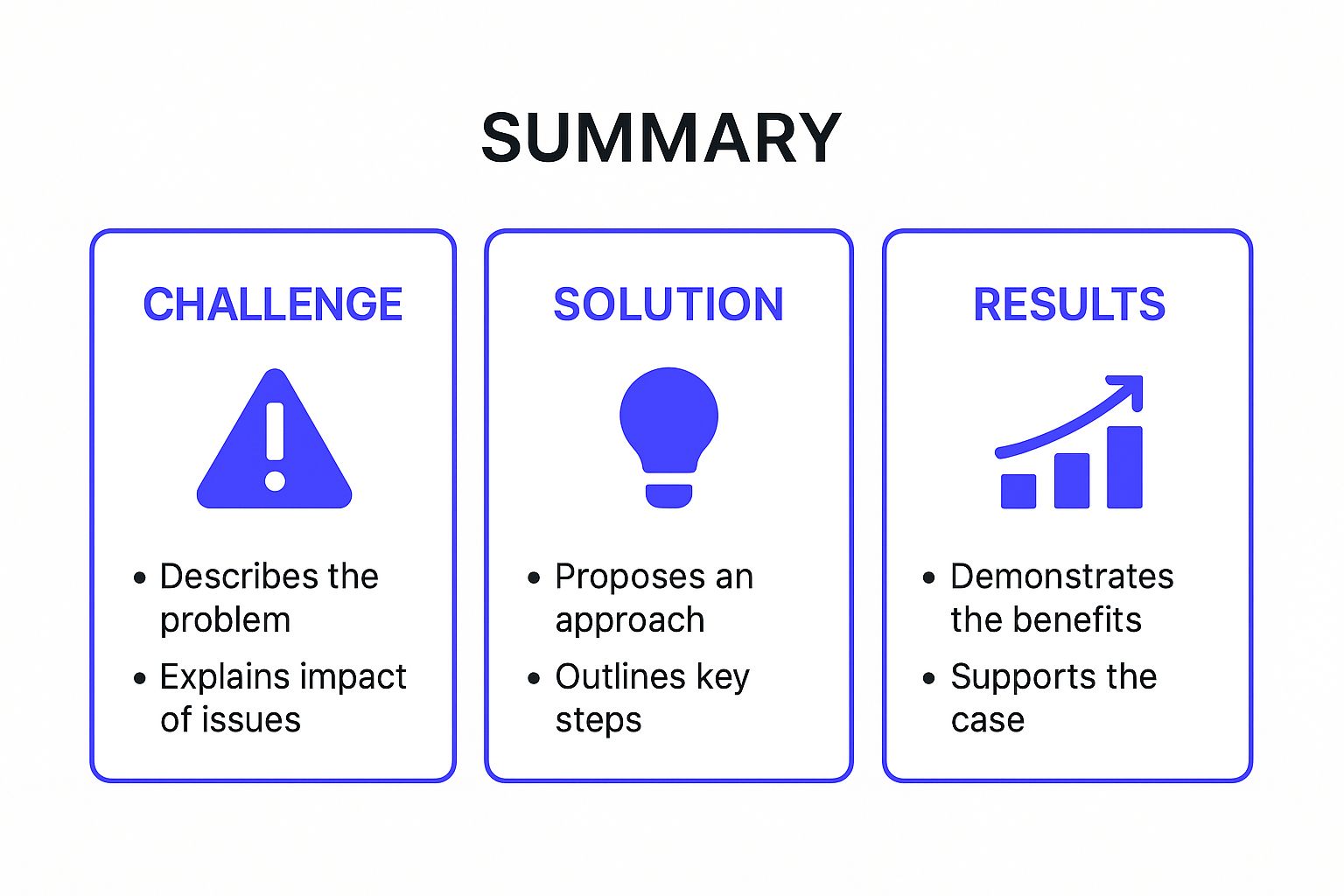
This template for testimonials excels because it presents a logical, data-backed argument for your product's value. B2B giants like Salesforce and Microsoft use this model to create powerful case studies that quantify efficiency gains and revenue growth, leaving no doubt about their solution's effectiveness. It's a pragmatic format designed for a skeptical, results-oriented audience.
How to Implement This Template
Gathering the right information for a PSR testimonial requires precision. Your questions should be direct and aimed at uncovering specific, quantifiable data points that build a compelling business case.
- The Problem: Ask about the specific operational or financial hurdles they faced. What process was broken? How much time or money was it costing them per week or month?
- The Solution: Pinpoint why your product was the answer. Which specific feature solved their core problem? What made it a better choice than competitors they considered?
- The Result: This is the most critical part. Demand numbers. Ask for hard data, like a 25% reduction in project completion time or a 50% increase in qualified leads. Frame results within a specific timeframe for maximum impact.
When to Use This Approach
The PSR template is the gold standard for B2B case studies, landing pages, and sales collateral where the audience values data over narrative. It’s perfect for convincing analytical buyers who need to justify their purchasing decisions to stakeholders. To gather this targeted feedback effectively, it's vital to implement customer survey best practices, ensuring you ask the right questions to get the data you need. Use this format when you want to make a clear, undeniable case for your product's ROI.
3. The Quote-Highlight Template
The Quote-Highlight Template is a concise, visually-appealing format that features an impactful customer quote as the primary element. This approach strips a testimonial down to its most powerful sentence, making it highly digestible and perfect for grabbing attention quickly. It’s designed for maximum visual impact and shareability, turning customer praise into a beautiful, branded asset.
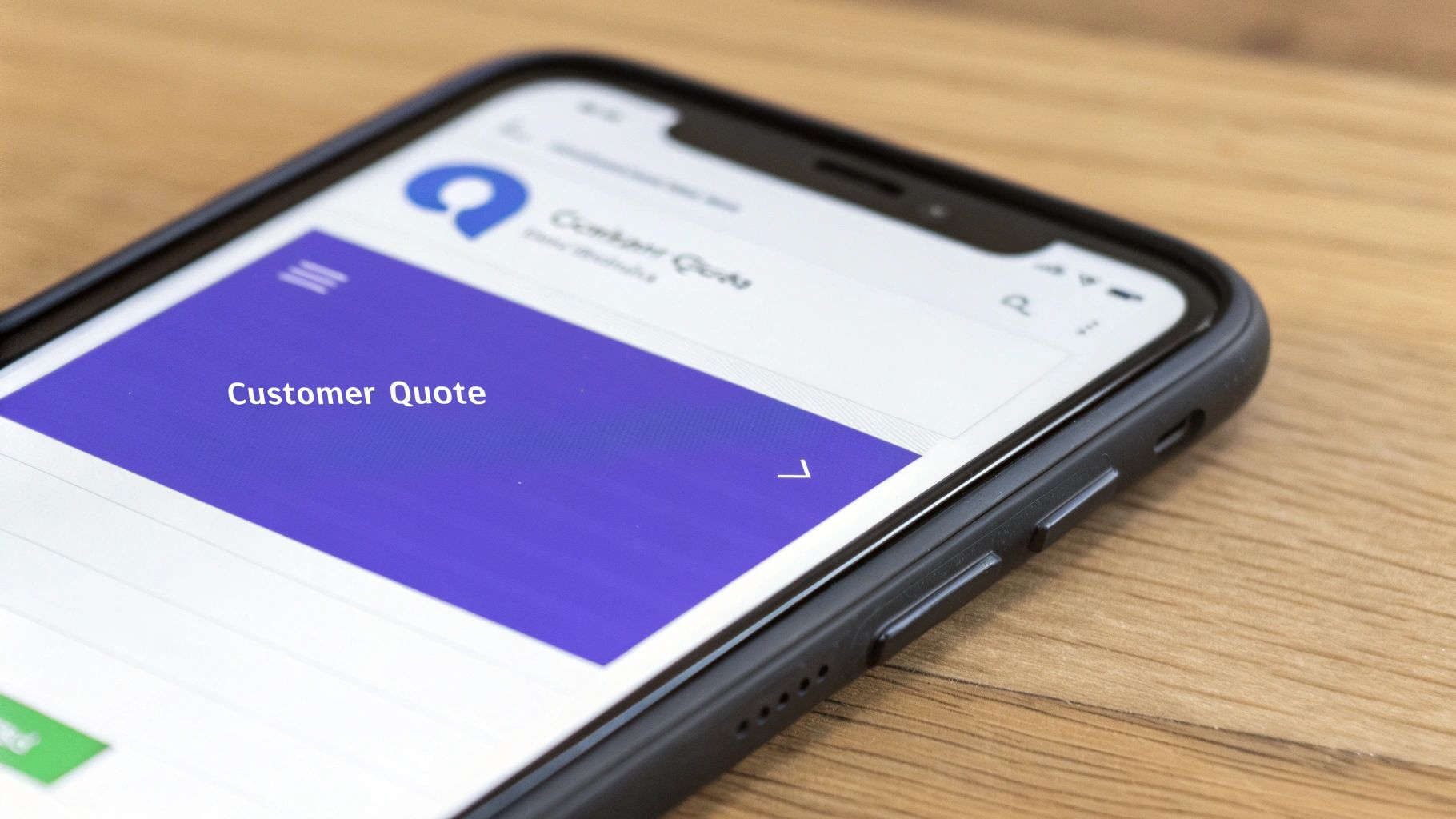
This template for testimonials excels where space is limited but impact needs to be high. It pairs a compelling quote with key customer details like their name, role, and a high-quality photo to build instant credibility. Companies like Canva and Squarespace masterfully use this format on their landing pages and in social media campaigns, using punchy user quotes to reinforce specific value propositions and build immediate trust with new visitors.
How to Implement This Template
Creating a compelling quote-highlight requires a keen eye for both words and design. The goal is to isolate the most persuasive part of a customer's feedback and present it in a way that is both authentic and visually aligned with your brand.
- Select the Perfect Quote: Scour your feedback channels for quotes that are specific, benefit-driven, and emotionally resonant. Look for a sentence that directly addresses a common pain point or highlights a killer feature.
- Add Authenticity: Always include a high-resolution photo of the customer, their full name, and their company or title. This visual proof transforms an anonymous quote into a genuine endorsement from a real person.
- Brand it Visually: Apply your brand’s fonts, colors, and logo to the design. This ensures consistency across your marketing materials and reinforces brand recognition every time the testimonial is shared. For example, a quote about saving 10 hours per week becomes far more powerful in a branded graphic.
When to Use This Approach
The Quote-Highlight Template is your go-to format for fast-paced digital environments. It's ideal for social media feeds (Instagram, LinkedIn, Twitter), website hero sections, and in-app pop-ups where you have only seconds to make an impression. Use it to break up longer text on landing pages or to add social proof next to a call-to-action, boosting conversion rates by providing a quick, credible nudge.
4. The Video Testimonial Template
The Video Testimonial Template moves beyond static text to a dynamic, multi-sensory format that captures customers speaking directly about their experience on camera. This approach leverages powerful visual and auditory cues, such as tone of voice and body language, to create authentic, trustworthy testimonials that are difficult to fake. Its high-engagement nature resonates strongly with audiences across all demographics, making it an incredibly effective tool for building social proof.
This template for testimonials adds a human face to your brand, fostering a deeper connection than a written quote ever could. It allows potential customers to see and hear the genuine satisfaction of real users, making the endorsement more credible and impactful. Companies like Dropbox and Zoom have leveraged this format to showcase customer success, creating compelling stories that bring the value of their services to life in a way that feels personal and genuine.
How to Implement This Template
Creating a professional video testimonial requires careful planning and execution. Guiding the customer and ensuring high production quality are key to making this format shine.
- Prepare Your Customer: Don't put them on the spot. Send a list of guiding questions in advance so they can gather their thoughts. This ensures they feel confident and can provide a concise, articulate account of their success.
- Focus on Production Quality: Use professional or high-quality lighting and audio equipment. A clear image and crisp sound are non-negotiable, as poor quality can undermine the testimonial's credibility.
- Keep it Concise and Accessible: Aim for a final video length of 60 to 90 seconds to maintain viewer engagement. Always include captions for accessibility and for viewers watching without sound.
When to Use This Approach
The video testimonial is perfect for deployment across multiple marketing channels, especially on visually-driven platforms like your website's homepage, landing pages, and social media feeds. It's particularly powerful for illustrating complex transformations or emotional journeys, such as Peloton's fitness stories. Create shorter, impactful clips from the main video to use as social media ads or posts, maximizing the content's reach and impact.
5. The Social Proof Carousel Template
The Social Proof Carousel Template leverages the power of volume to build instant credibility. Instead of a single, detailed story, this format displays a collection of shorter testimonials in a dynamic, rotating carousel or grid layout. This approach creates a powerful visual effect of widespread customer satisfaction, assuring prospects that they are making a popular and validated choice.
This template for testimonials is designed to showcase variety and quantity, which serves as strong social proof. When a potential customer sees numerous positive reviews from diverse users, it quickly alleviates doubt and builds confidence. E-commerce giants like Amazon and review aggregators like Trustpilot and G2 have perfected this model, using carousels to highlight a constant stream of positive feedback that reinforces product value and trustworthiness.
How to Implement This Template
To create an effective social proof carousel, focus on curation, design, and user experience. The goal is to present a high volume of feedback in a way that is engaging and easy to digest, not overwhelming.
- Curate for Variety: Mix different types of testimonials. Include quotes from various customer segments, highlight different use cases, and showcase users from different industries or company sizes. This demonstrates broad appeal.
- Incorporate Visual Cues: Add star ratings, scores, or headshots to each testimonial. These visual elements allow prospects to assess satisfaction at a glance and add a human touch.
- Ensure Freshness and Functionality: Regularly update the carousel with new reviews to keep the content fresh and relevant. For WordPress users, learning how to go about displaying Elementor Google reviews can automate this process and integrate real-time feedback directly onto your site.
When to Use This Approach
This template is perfect for homepages, pricing pages, or landing pages where you need to make a strong, immediate impression. It is highly effective for SaaS products with a large user base and a steady flow of positive feedback. By displaying a high volume of satisfied customers, you can quickly build trust and encourage conversion without requiring the prospect to read a lengthy case study. You can explore more ideas for adding testimonials to a website to maximize their impact.
6. The Comparison/Before-After Template
The Comparison/Before-After Template offers a direct and visually impactful way to showcase transformation. It explicitly contrasts the customer's state before using your product with the results achieved afterward. This format is incredibly persuasive because it provides clear, undeniable proof of value, simplifying complex outcomes into an easily digestible snapshot of success.

This template for testimonials is a favorite in industries where results are tangible, from fitness programs showing physical changes to SaaS platforms demonstrating massive efficiency gains. By placing two scenarios side-by-side, you eliminate ambiguity and allow prospects to immediately grasp the tangible benefits your solution provides. Companies like Asana often use this to show how teams went from chaotic project management to streamlined, on-time delivery.
How to Implement This Template
Capturing a compelling before-and-after narrative requires focusing on concrete, measurable changes. Your goal is to create a stark contrast that highlights the value delivered.
- Define the "Before" State: Ask customers to describe their world without your product. What were the specific metrics of their struggle? For example, "We spent 15 hours per week on manual data entry."
- Highlight the "After" State: Prompt them for the new reality. What are the quantifiable results now? Following the example, this would be, "After implementing the software, we automated the process and now spend just 1 hour per week on it."
- Visualize the Contrast: Whenever possible, use visuals. This could be side-by-side screenshots, performance graphs, or charts showing key metrics like revenue growth or time saved.
When to Use This Approach
This template is most effective when your product creates clear, measurable, or visual improvements. Use it on landing pages, in pricing sections, and within ad creatives where you have seconds to capture attention and communicate value. It’s perfect for demonstrating ROI for B2B software, showing productivity boosts, or illustrating any scenario where the "after" state is a significantly better version of the "before."
7. The Expert/Authority Testimonial Template
The Expert/Authority Testimonial leverages social proof from a highly influential source: a recognized industry expert, thought leader, or authoritative figure. This format builds credibility by association, transferring the trust and respect commanded by the expert directly to your brand. When a respected voice vouches for your solution, it acts as a powerful shortcut to establishing market legitimacy and overcoming skepticism.
This template for testimonials is about more than just a positive review; it’s a strategic endorsement. It signals to potential customers that your product meets the high standards of those who know the industry best. B2B technology companies often feature quotes from respected industry analysts, while professional services firms might showcase recommendations from former executives in their target vertical, instantly boosting their perceived value.
How to Implement This Template
Securing an endorsement from an authority figure requires a strategic approach built on relationships and clear value demonstration. You need to make it easy for them to see why your product is worthy of their stamp of approval.
- Identify & Engage: Pinpoint experts whose audience and expertise align perfectly with your product. Build a genuine relationship before making an ask. Engage with their content and offer value first.
- Provide a Compelling Case: When you reach out, clearly articulate your value proposition and provide them with everything they need for an evaluation, such as a private demo or a premium account.
- Highlight Their Credentials: When publishing the testimonial, always include the expert's name, title, company, and a key achievement. This context is what gives their endorsement weight and credibility.
When to Use This Approach
This approach is most effective when entering a new market, launching a high-value product, or trying to differentiate in a crowded space. Use expert testimonials prominently on your homepage, landing pages, and in pitch decks to make a strong first impression. It's particularly powerful for B2B SaaS, where purchasing decisions are heavily influenced by industry reputation and trust. For more strategies on outreach, you can learn more about how to get customer testimonials.
8. The Objection-Handling Testimonial Template
The Objection-Handling Testimonial is a strategic asset designed to proactively neutralize a potential customer's biggest doubts. Instead of waiting for prospects to raise concerns about price, security, or complexity, this format uses the voice of a satisfied customer who once shared those very same hesitations. By featuring a client who overcame their initial skepticism, you build credibility and disarm objections before they derail the sales process.
This template for testimonials is a powerful tool for conversion optimization because it directly addresses the friction points in the buyer's journey. It acknowledges the validity of a concern while immediately providing a real-world example of a positive outcome, turning a potential weakness into a testament of your product's strength. This method, often championed by sales experts and customer success teams, builds trust by showing you understand and have successfully resolved your customers' primary concerns.
How to Implement This Template
Creating an effective objection-handling testimonial requires you to pinpoint and address specific barriers. Guide the customer to speak directly to the hesitation they once felt, creating a powerful and relatable message for prospects.
- Identify the Objection: Start by asking the customer about their initial doubts. What almost stopped them from buying? Was it the price, a missing feature, or implementation fears? Frame the question directly: "What was your biggest concern before you signed up?"
- Detail the Resolution: Ask how their experience proved that initial concern wrong. How did your product or team alleviate their worries? What was the specific moment or feature that changed their mind?
- Highlight the Positive Outcome: Conclude by focusing on the value they gained by moving past their objection. Ask, "Looking back, what would you say to someone who has the same concern you did?" This prompts a direct, peer-to-peer recommendation.
When to Use This Approach
This format is invaluable for bottom-of-the-funnel marketing activities where prospects are close to a decision but may have lingering doubts. Use these testimonials on pricing pages to address cost concerns, in security-focused landing pages, or within sales proposals and FAQ sections. It's especially effective for high-ticket SaaS products where ROI and security are common objections, helping to provide the final nudge a hesitant lead needs to convert.
Testimonial Template Comparison Summary
TemplateImplementation Complexity 🔄Resource Requirements ⚡Expected Outcomes 📊Ideal Use Cases 💡Key Advantages ⭐The Story-Driven TestimonialMedium to High - narrative depthModerate - interviews & editingEmotional connection, comprehensive value storyBranding, in-depth customer journeys, trust-buildingStrong emotional appeal, detailed context, memorableThe Problem-Solution-Result (PSR)Low to Medium - structured formatLow - data & metric collectionClear ROI demonstration, easy scanningB2B sales, decision-makers, presentationsConcrete evidence, concise, appeals to analytical audiencesThe Quote-HighlightLow - simple design focusLow - quote collection & designHigh visual impact, quick social proofSocial media, website headers, limited space marketingQuick to understand, highly shareable, versatileThe Video TestimonialHigh - production & editingHigh - equipment & timeAuthenticity, trust, engagementMulti-demographic digital campaigns, conversion-focusedMost authentic and engaging, strong emotional connectionThe Social Proof CarouselMedium - UI/UX and content mgmtMedium - diverse testimonialsBroad social proof by volumeE-commerce, social media integrationsDemonstrates wide approval, easy updates, visual varietyThe Comparison/Before-AfterMedium - requires visual/dataMedium - visuals and metricsClear transformation, persuasive evidenceProducts/services with visible/measurable improvementsConcrete ROI, easy visualization, memorable impactThe Expert/Authority TestimonialMedium - expert relationship mgmtMedium to High - expert sourcingEnhanced credibility and trustB2B, professional services, industry validationBuilds instant trust, industry validation, brand boostThe Objection-Handling TestimonialMedium - careful customer choiceMedium - selective testimonialReduced sales friction, increased conversionsSales objections, high-ticket sales, skeptical customersAddresses concerns honestly, builds trust, boosts conversions
Final Thoughts
We've explored a powerful arsenal of eight distinct testimonial templates, each designed to transform generic customer feedback into compelling social proof. Moving beyond simple quotes is the key to unlocking the true potential of your customers' success stories. The templates we've covered, from the narrative power of the Story-Driven and Problem-Solution-Result frameworks to the visual impact of Video Testimonials and Social Proof Carousels, provide a structured approach for every scenario.
The journey doesn't end with collecting a few good reviews. The real magic happens when you strategically deploy the right format to achieve a specific goal. Are you trying to overcome a common sales objection? The Objection-Handling Testimonial Template is your best tool. Need to showcase a dramatic improvement for a specific use case? The Comparison/Before-After Template delivers that impact with visual clarity.
From Templates to a Cohesive Strategy
Mastering the use of a versatile template for testimonials is a critical skill for any SaaS team. It’s about more than just filling in blanks; it’s about understanding the psychology behind what makes a testimonial resonate with a prospective customer. Each template serves a unique purpose:
- Building emotional connection through authentic stories.
- Demonstrating tangible ROI with data-backed results.
- Establishing credibility by featuring industry experts.
- Addressing audience skepticism head-on with targeted proof.
By integrating these diverse formats, you create a rich tapestry of social proof that speaks to different segments of your audience at various stages of their buying journey. This targeted approach ensures your testimonials aren't just background noise but active, persuasive assets that drive conversions. For a holistic approach, consider how these templates fit into your overall digital marketing strategy template to ensure your customer voice is a cornerstone of your growth engine.
Ultimately, the goal is to create a system where collecting and deploying high-impact testimonials is a seamless, repeatable process. This empowers your marketing, sales, and product teams to leverage the voice of your happiest customers consistently and effectively. By embracing this strategic approach, you're not just showcasing satisfaction; you're building a powerful, undeniable case for why your solution is the best choice on the market.
Ready to automate your testimonial collection process and get more powerful customer stories? Surva.ai helps you send intelligent, AI-powered surveys that guide your customers to provide the exact feedback you need for these templates. Stop chasing testimonials and start collecting them effortlessly with Surva.ai.
